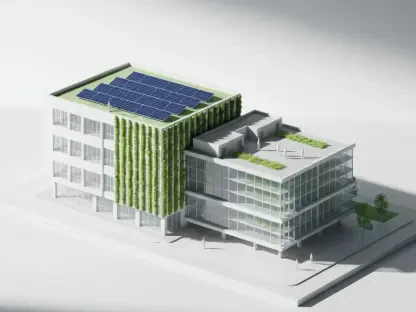The UK construction sector is currently navigating one of its most challenging periods, with activity levels plummeting to a low not seen in over five years. As of the third quarter, the industry has recorded a staggering drop, with the S&P Global UK Construction Purchasing Managers’ Index (PMI) falling to 44.3 in July from 48.8 in June, signaling a severe contraction. This downturn has cast a shadow over all major sub-sectors, including residential building, civil engineering, and commercial construction. The sharp decline raises critical questions about the underlying causes and the broader economic implications for a sector that plays a pivotal role in national growth. Delving into the reasons behind this slump reveals a complex interplay of demand issues, economic uncertainty, and operational adjustments, painting a sobering picture of an industry under immense pressure.
Unpacking the Current Downturn
Steep Contraction Across Sub-Sectors
The extent of the decline in UK construction is evident across all major areas of activity, with civil engineering bearing the brunt of the downturn. This sub-sector has experienced the most significant drop, reflecting a sharp reduction in infrastructure projects and public sector initiatives. Meanwhile, residential building, already grappling with challenges, has seen a renewed decline, as housing projects stall amid weaker demand. Commercial construction, while slightly less affected, still faces a notable softening, driven by hesitancy among businesses to invest in new developments. Surveyed firms have pointed to site delays and a lack of incoming business as key contributors to this widespread contraction. The ripple effects are felt throughout supply chains and labor markets, as companies scale back operations to weather the storm. This broad-based decline underscores the severity of the current environment, where no segment of the industry remains untouched by the prevailing headwinds, creating a challenging landscape for stakeholders at every level.
Persistent Demand Challenges
Beyond the immediate numbers, the construction sector is grappling with a sustained lack of demand that shows no signs of abating. New work volumes have declined for the seventh consecutive month, with the rate of contraction accelerating to its fastest pace since early this year. Firms report a troubling combination of reduced customer confidence and fewer tender opportunities, which stifles project pipelines. Additionally, the hesitancy of clients to commit to new builds or renovations reflects broader economic uncertainty, both domestically and on a global scale. This environment has led to a significant drop in investment appetite, as businesses and public entities alike adopt a wait-and-see approach. The cumulative impact of these demand-side pressures has forced many companies to reassess their strategies, prioritizing survival over expansion. As a result, the sector finds itself in a vicious cycle where declining activity further erodes confidence, making recovery an increasingly distant prospect in the near term.
Looking Ahead Amid Uncertainty
Cautious Optimism for Future Growth
Despite the grim reality of the present, some glimmers of hope persist among UK construction firms regarding future prospects. A slight uptick in confidence has been noted compared to the two-and-a-half-year low recorded in June, though optimism remains relatively weak when viewed against long-term trends. Over the next 12 months, certain companies anticipate a potential rebound, driven by expectations of stabilizing economic conditions or renewed public sector spending. However, this forward-looking sentiment is tempered by the harsh realities of current market dynamics, where investment remains subdued. Joe Hayes, Principal Economist at S&P Global Market Intelligence, has highlighted the severity of the contraction, particularly in residential and civil engineering work, noting that uncertainty continues to stifle growth. This cautious outlook reflects a sector that, while hopeful, is far from confident, as firms navigate a landscape fraught with risks and limited catalysts for immediate recovery.
Operational Adjustments and Scaling Back
In response to the ongoing challenges, many construction firms are taking proactive steps to mitigate risks by scaling back operations. Purchasing of materials has seen the softest decline since the start of the year, indicating a deliberate reduction in inventory as companies brace for leaner times. Similarly, workforce numbers are being trimmed, with layoffs and hiring freezes becoming more common as firms adjust to lower activity levels. These measures, while necessary for short-term financial stability, signal a deeper retreat within the industry, as businesses prioritize cost-cutting over growth initiatives. The reduction in resources and staffing also poses long-term risks, potentially hampering the sector’s ability to ramp up quickly should demand return. As economic uncertainty lingers, these operational adjustments paint a picture of an industry in survival mode, carefully calibrating its capacity to match a diminished project pipeline while hoping for a more favorable outlook in the months ahead.
Reflecting on a Sector Under Strain
Navigating Past Challenges with New Strategies
Looking back, the UK construction sector endured a period of unprecedented difficulty, with activity levels hitting their lowest point in over five years during the third quarter. The sharp declines across civil engineering, residential building, and commercial projects underscored the depth of the crisis that gripped the industry. Economic uncertainty and waning demand were relentless forces, driving firms to adapt under intense pressure. The insights from surveyed companies and economists alike painted a stark reality of delayed projects and stifled investment, which defined the struggles of that time. Yet, within those challenges lay lessons that could inform future resilience, as the sector sought ways to weather such storms. Reflecting on those hardships, it became clear that strategic foresight and adaptability were crucial for survival in such turbulent conditions.
Building Toward Recovery
As the industry looks beyond those tough times, actionable steps emerged as vital for paving the way to recovery. Strengthening collaboration between public and private sectors could help revive stalled projects, particularly in infrastructure and housing, where needs remain high. Policymakers might consider targeted incentives to boost investor confidence and stimulate demand, while firms should focus on diversifying their portfolios to mitigate risks tied to specific sub-sectors. Embracing digital tools and sustainable practices could also position companies to meet evolving market expectations, offering a competitive edge. While confidence remained low during the downturn, fostering innovation and flexibility will be key to seizing future opportunities. By addressing structural weaknesses and aligning with broader economic trends, the construction sector can aim to rebuild on a stronger foundation, turning past setbacks into stepping stones for sustainable growth in the years ahead.









